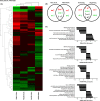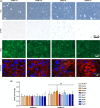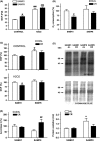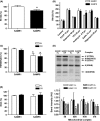In vitro caloric restriction induces protective genes and functional rejuvenation in senescent SAMP8 astrocytes
- PMID: 25711920
- PMCID: PMC4406662
- DOI: 10.1111/acel.12259
In vitro caloric restriction induces protective genes and functional rejuvenation in senescent SAMP8 astrocytes
Abstract
Astrocytes are key cells in brain aging, helping neurons to undertake healthy aging or otherwise letting them enter into a spiral of neurodegeneration. We aimed to characterize astrocytes cultured from senescence-accelerated prone 8 (SAMP8) mice, a mouse model of brain pathological aging, along with the effects of caloric restriction, the most effective rejuvenating treatment known so far. Analysis of the transcriptomic profiles of SAMP8 astrocytes cultured in control conditions and treated with caloric restriction serum was performed using mRNA microarrays. A decrease in mitochondrial and ribosome mRNA, which was restored by caloric restriction, confirmed the age-related profile of SAMP8 astrocytes and the benefits of caloric restriction. An amelioration of antioxidant and neurodegeneration-related pathways confirmed the brain benefits of caloric restriction. Studies of oxidative stress and mitochondrial function demonstrated a reduction of oxidative damage and partial improvement of mitochondria after caloric restriction. In summary, caloric restriction showed a significant tendency to normalize pathologically aged astrocytes through the activation of pathways that are protective against the age-related deterioration of brain physiology.
Keywords: RNA microarrays; SAMP8; astrocytes; caloric restriction; mitochondria; oxidative stress.
© 2014 The Authors. Aging Cell published by the Anatomical Society and John Wiley & Sons Ltd.
Figures




Similar articles
-
Dysfunction of astrocytes in senescence-accelerated mice SAMP8 reduces their neuroprotective capacity.Aging Cell. 2008 Oct;7(5):630-40. doi: 10.1111/j.1474-9726.2008.00410.x. Epub 2008 Jul 24. Aging Cell. 2008. PMID: 18616637
-
Intracerebral hemorrhage-induced brain injury is aggravated in senescence-accelerated prone mice.Stroke. 2006 Jan;37(1):216-22. doi: 10.1161/01.STR.0000195151.46926.7b. Epub 2005 Dec 1. Stroke. 2006. PMID: 16322488
-
Neurons from senescence-accelerated SAMP8 mice are protected against frailty by the sirtuin 1 promoting agents melatonin and resveratrol.J Pineal Res. 2012 Apr;52(3):271-81. doi: 10.1111/j.1600-079X.2011.00939.x. Epub 2011 Nov 16. J Pineal Res. 2012. PMID: 22085194
-
Targeting cellular senescence based on interorganelle communication, multilevel proteostasis, and metabolic control.FEBS J. 2021 Jun;288(12):3834-3854. doi: 10.1111/febs.15631. Epub 2020 Dec 8. FEBS J. 2021. PMID: 33200494 Free PMC article. Review.
-
The mitochondrial free radical theory of aging.Prog Mol Biol Transl Sci. 2014;127:1-27. doi: 10.1016/B978-0-12-394625-6.00001-5. Prog Mol Biol Transl Sci. 2014. PMID: 25149212 Review.
Cited by
-
Caloric Restriction May Help Delay the Onset of Frailty and Support Frailty Management.Front Nutr. 2021 Sep 6;8:731356. doi: 10.3389/fnut.2021.731356. eCollection 2021. Front Nutr. 2021. PMID: 34552957 Free PMC article. Review.
-
Understanding Epigenetics in the Neurodegeneration of Alzheimer's Disease: SAMP8 Mouse Model.J Alzheimers Dis. 2018;62(3):943-963. doi: 10.3233/JAD-170664. J Alzheimers Dis. 2018. PMID: 29562529 Free PMC article. Review.
-
Dietary Restriction and Neuroinflammation: A Potential Mechanistic Link.Int J Mol Sci. 2019 Jan 22;20(3):464. doi: 10.3390/ijms20030464. Int J Mol Sci. 2019. PMID: 30678217 Free PMC article. Review.
-
Calorie Restriction Rescues Mitochondrial Dysfunction in Adck2-Deficient Skeletal Muscle.Front Physiol. 2022 Jul 14;13:898792. doi: 10.3389/fphys.2022.898792. eCollection 2022. Front Physiol. 2022. PMID: 35936917 Free PMC article.
-
RAC3 more than a nuclear receptor coactivator: a key inhibitor of senescence that is downregulated in aging.Cell Death Dis. 2015 Oct 15;6(10):e1902. doi: 10.1038/cddis.2015.218. Cell Death Dis. 2015. PMID: 26469953 Free PMC article.
References
-
- Balaban RS, Nemoto S, Finkel T. Mitochondria, oxidants, and aging. Cell. 2005;120:483–495. - PubMed
-
- Barger JL, Kayo T, Vann JM, Arias EB, Wang J, Hacker TA, Wang Y, Raederstorff D, Morrow JD, Leeuwenburgh C, Allison DB, Saupe KW, Cartee GD, Weindruch R, Prolla TA. A low dose of dietary resveratrol partially mimics caloric restriction and retards aging parameters in mice. PLoS ONE. 2008;3:e2264. - PMC - PubMed
-
- Bélanger M, Allaman I, Magistretti PJ. Brain energy metabolism: focus on astrocyte-neuron metabolic cooperation. Cell Metab. 2011;14:724–738. - PubMed
Publication types
MeSH terms
Substances
LinkOut - more resources
Full Text Sources
Other Literature Sources
Medical
Molecular Biology Databases

